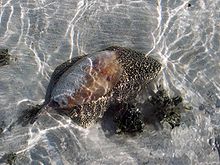
A seashell or sea shell, also known simply as a shell, is a hard, protective outer layer usually created by an animal or organism that lives in the sea. The shell is part of the body of the animal. Empty seashells are often found washed up on beaches by beachcombers. The shells are empty because the animal has died and the soft parts have decomposed or been eaten by another animal.

Volutidae, common name volutes, are a taxonomic family of predatory sea snails that range in size from 9 mm to over 500 mm. They are marine gastropod mollusks. Most of the species have no operculum.

The Trochidae, common name top-snails or top-shells, are a family of various sized sea snails, marine gastropod molluscs in the subclass Vetigastropoda. This family is commonly known as the top-snails because in many species the shell resembles a toy spinning top.

Melo miltonis, the southern bailer or southern baler, is a large sea snail, a marine gastropod mollusc in the family Volutidae, the volutes.
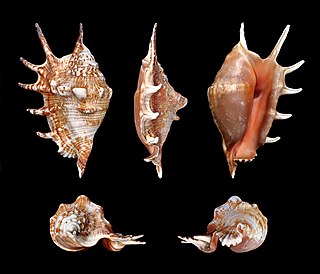
Lambis lambis, common name the spider conch, is a species of large sea snail, a marine gastropod mollusk in the family Strombidae, the true conchs.
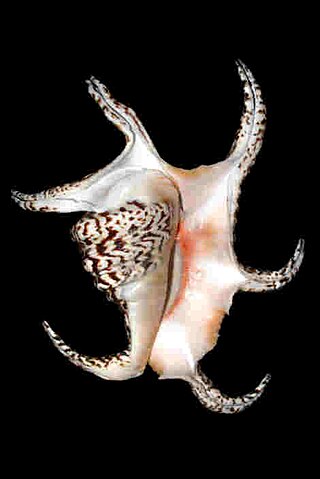
Harpago chiragra, common name the Chiragra spider conch, is a species of very large sea snail, a marine gastropod mollusk in the family Strombidae, the true conchs.
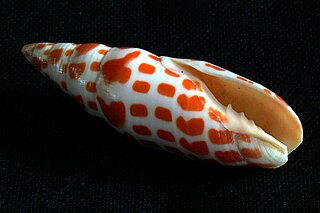
Mitra mitra, common name the episcopal miter, is a species of large predatory sea snail, a marine gastropod mollusk in the family Mitridae, the miters.

Melo melo, common name the Indian volute or bailer shell, is a very large edible sea snail, a marine gastropod mollusc in the family Volutidae, the volutes.

Strombus pugilis, common names the fighting conch and the West Indian fighting conch, is a species of medium to large sea snail, a marine gastropod mollusk in the family Strombidae, the true conchs.

Lentigo lentiginosus, common name the silver conch, is a species of medium-sized sea snail, a marine gastropod mollusk in the family Strombidae, the true conchs.

Syrinx aruanus, common name the Australian trumpet or false trumpet, is a species of extremely large sea snail measuring up to 72 cm long and weighing up to 18 kg. It is a marine gastropod mollusk in the family Turbinellidae, and is the only species in the genus Syrinx.

Euprotomus aurisdianae, common name the Diana conch, is a species of small to medium-sized sea snail, a marine gastropod mollusk in the family Strombidae, the true conchs.
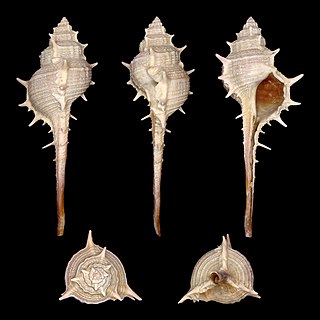
Murex trapa, common name the rare-spined murex, is a species of sea snail, a marine gastropod mollusc of the family Muricidae, the rock snails.

Leporicypraea mappa, common name the map cowry, is a species of large sea snail, a cowry, a marine gastropod mollusk in the family Cypraeidae, the cowries.

Voluta ebraea, common name the Hebrew volute, is a species of medium-sized sea snail, a marine gastropod mollusk in the family Volutidae, the volutes. The Hebrew volute is endemic to Brazil, where it is collected both for food and for its shell, which is highly desired for ornamental purposes. Recent studies indicate that natural populations of Voluta ebraea may be suffering declines due to overfishing and overexploitation.

Chicoreus ramosus, common name the ramose murex or branched murex, is a species of predatory sea snail, a marine gastropod mollusk in the family Muricidae, the murex snails. It is considered an economically important species in the Indo-West Pacific, especially in India.

Conus flavidus, common name the flavid Pacific cone, is a species of sea snail, a marine gastropod mollusk in the family Conidae, the cone snails and their allies.

Amoria undulata, common name wavy volute, is a species of sea snail, a marine gastropod mollusk in the family Volutidae, the volutes.

Melo broderipii is a species of sea snail, a marine gastropod mollusk in the family Volutidae, the volutes.

Titanostrombus galeatus, commonly known as the Eastern Pacific giant conch, is a species of large sea snail, a marine gastropod mollusk in the family Strombidae, the true conchs and their allies.
